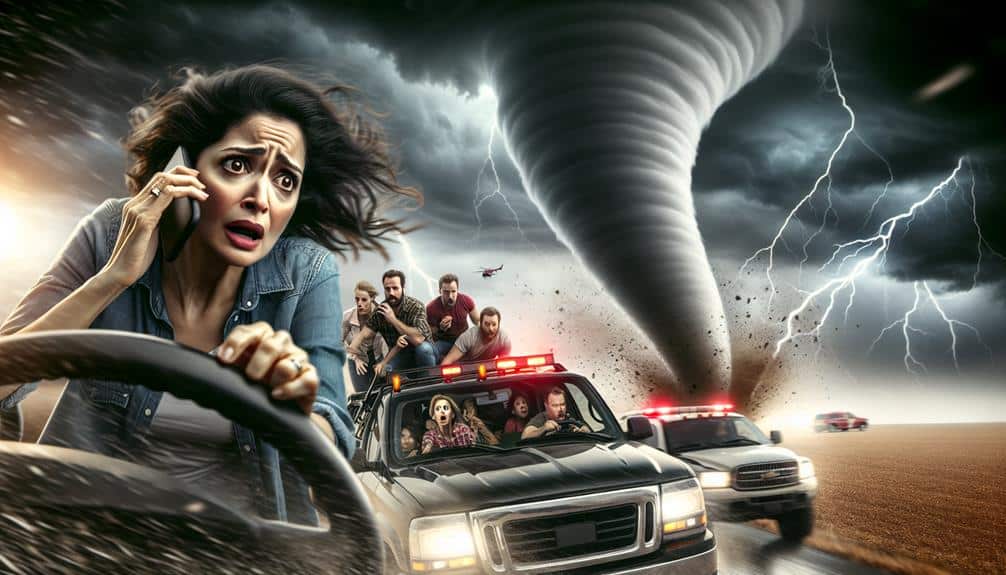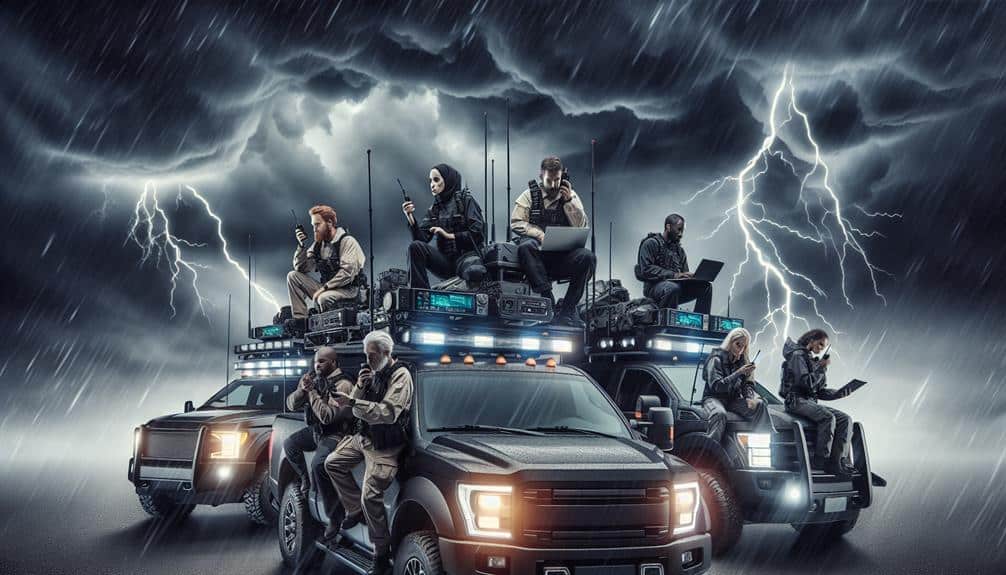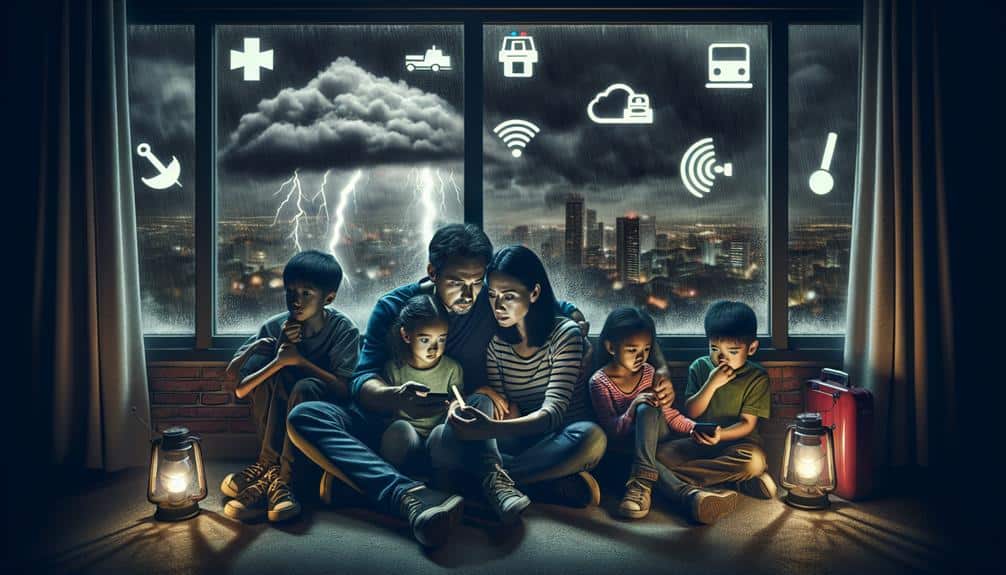To create efficient emergency communication channels during storms, we depend on various tools like mobile alerts, social media, battery-powered radios, and community apps. Setting up a clear communication protocol with specific check-in times and designated spokespersons guarantees organized information flow. Training through drills and workshops builds confidence and keeps everyone prepared. Real-time data from weather stations and satellites enables quick decision-making. Coordinating with local authorities ensures streamlined responses and efficient resource allocation. Our multi-faceted approach guarantees continuous updates and community safety during storms. For a more in-depth exploration of each step, we'll provide detailed strategies.
Key Points
- Use mobile alerts for real-time storm path and evacuation updates.
- Establish direct communication lines with local authorities for rapid information sharing.
- Train team members with simulated drills and crisis response workshops.
- Utilize battery-operated radios and text messages during power outages.
Identifying Reliable Communication Tools
When preparing for storms, we must first identify reliable communication tools to ensure our safety and coordination. It's vital to utilize a mix of modern and traditional methods to stay informed and connected.
Mobile alerts are a powerful and immediate way to receive updates directly to our devices. These alerts can provide real-time information on storm paths and evacuation orders, ensuring we stay one step ahead.
Social media platforms also play a crucial role. By following official accounts and local news, we can access timely updates and share important information with our networks.
Radio broadcasts remain essential, especially when internet and mobile networks falter. A battery-powered or hand-crank radio should be part of our emergency kit. Tuning into local stations can keep us informed about weather conditions and emergency instructions.
Additionally, community apps offer a platform for neighbors to share information and resources. Apps like Nextdoor or local emergency management apps provide localized updates and allow us to communicate with those nearby.
Establishing a Communication Protocol
Having identified our dependable communication tools, we must now establish a clear protocol to safeguard everyone knows how and when to use them during a storm.
First, we need to outline specific communication guidelines. These guidelines should detail the chain of command, the designated spokespersons, and the preferred communication methods for different scenarios. For instance, in case of power outages, we might rely on battery-operated radios or text messages.
Next, we should compile a detailed list of emergency contacts. This list should include internal team members, local authorities, emergency services, and utility companies. Each contact should have multiple communication options, such as phone numbers and email addresses, to guarantee redundancy.
Additionally, it's essential to set specific times for check-ins and status updates. Regular updates can help us stay informed about each other's safety and the storm's progress. By adhering to these communication guidelines, we promote a sense of preparedness and cohesion.
Training for Emergency Situations
To make certain everyone is prepared, we need detailed training sessions that simulate real emergency scenarios. These simulated drills allow us to practice our responses and refine our communication strategies under pressure. By engaging in these realistic exercises, we can identify weaknesses in our current plans and make necessary adjustments before an actual crisis strikes.
Crisis response workshops are another crucial component of our training program. In these sessions, we focus on developing the skills needed to manage stress, make quick decisions, and maintain clear communication lines. Participants learn to handle various emergency situations, from severe storms to power outages, ensuring they're ready to act effectively when it matters most.
We can't underestimate the importance of hands-on experience. By repeatedly practicing our emergency protocols, we build confidence and ensure that everyone knows their role. This preparation is essential for maintaining order and safety during a storm.
Our goal is to empower every team member with the knowledge and skills they need to navigate emergencies efficiently. With detailed training that includes simulated drills and crisis response workshops, we're better equipped to face any storm head-on, protecting our freedom and security.
Utilizing Real-Time Data Sharing
Real-time data sharing allows us to make informed decisions swiftly during a storm. By integrating data from various sources—weather stations, satellites, and on-the-ground reports—we can create a detailed picture of the storm's progression. This data integration allows us to provide timely updates to our communities, making sure everyone has the information they need to stay safe.
Information sharing is essential in these situations. When we share real-time data with emergency responders, local governments, and the public, we empower everyone to act quickly and effectively. For example, real-time updates on storm paths and intensity can help residents decide whether to evacuate or shelter in place. It also assists emergency services in deploying resources where they're most needed.
We must prioritize the seamless flow of information. By leveraging modern technologies, such as mobile apps and social media platforms, we can disseminate important updates instantly. Our goal is to guarantee no one is left in the dark.
When we harness the power of real-time data sharing, we enhance our collective ability to respond to storms, minimizing risk and maximizing safety for all.
Coordinating With Local Authorities

Building on the foundation of real-time data sharing, we must collaborate closely with local authorities to guarantee coordinated and effective storm response efforts. When storms hit, community partnerships become essential in streamlining our emergency response. By working hand-in-hand with local emergency management agencies, police, fire departments, and public health organizations, we can guarantee that critical information flows smoothly and reaches those who need it most.
We should establish direct communication lines with local authorities well before a storm occurs. This preparation allows us to share updates quickly and respond to changing conditions in real-time. Coordinated efforts mean that resources are allocated efficiently, reducing delays in assistance and minimizing confusion among residents.
Moreover, leveraging community partnerships enhances our ability to disseminate accurate and timely information. Local authorities often have established networks and trusted channels within the community, making them invaluable in spreading alerts and safety instructions. By aligning our communication strategies with theirs, we amplify our reach and effectiveness.
In essence, our collaborative approach not only fortifies our emergency response but also empowers our community. By standing united with local authorities, we assure that every citizen has the information and support they need to weather the storm.
Frequently Asked Questions
How Can We Ensure Messages Reach People With Disabilities During a Storm?
We guarantee messages reach people with disabilities by using accessible resources and inclusion strategies. We must adapt communication methods, making certain everyone gets critical information. Our commitment to inclusivity guarantees freedom and safety for all during emergencies.
What Role Do Social Media Platforms Play in Emergency Communication?
Imagine social media as a lighthouse in a stormy sea. It provides real-time updates and fosters community engagement, guiding us safely through chaos. Platforms like Twitter and Facebook guarantee we're connected and informed swiftly and effectively.
How Often Should Emergency Communication Plans Be Updated?
We should update our emergency communication plans every six months. This frequency of updates guarantees we stay prepared. The significance of review can't be overstated; regular checks help us adapt to new challenges and maintain effectiveness.
What Are the Best Practices for Multilingual Communication During Emergencies?
We can't emphasize enough how important language diversity and cultural sensitivity are. Using high-quality translation services and fostering community engagement guarantees everyone understands emergency updates, keeping our diverse community safe and informed in critical times.
How Can We Address Misinformation During a Storm?
We can tackle misinformation management by verifying facts swiftly and engaging the community. Education campaigns are essential to keep everyone informed and aware, ensuring we all have the freedom to act on accurate information during the storm.


